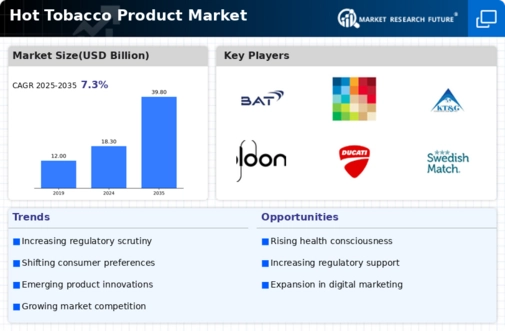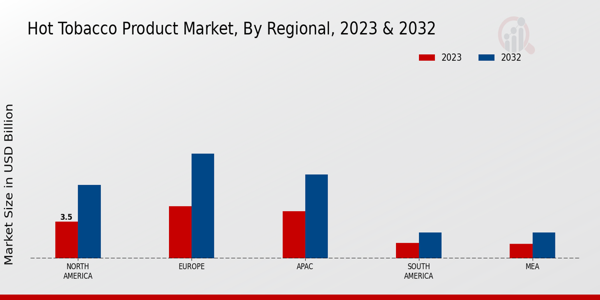Regulatory Changes
The Global Hot Tobacco Product Market Industry is influenced by evolving regulatory landscapes across various regions. Governments are increasingly recognizing the potential of hot tobacco products as alternatives to traditional smoking, leading to more favorable regulations. For example, some countries are implementing policies that promote the use of reduced-risk products, which could enhance market growth. However, regulatory challenges remain, as some jurisdictions impose strict advertising and sales restrictions. Despite these hurdles, the overall trend suggests a gradual acceptance of hot tobacco products, contributing to an anticipated compound annual growth rate of 7.32% from 2025 to 2035.
Changing Demographics
Demographic shifts are playing a crucial role in shaping the Global Hot Tobacco Product Market Industry. Younger generations, particularly millennials and Gen Z, are more open to experimenting with new smoking alternatives, including hot tobacco products. This demographic is often more health-conscious and tech-savvy, making them prime targets for innovative tobacco products. As these younger consumers become a larger segment of the market, their preferences will likely drive demand for products that align with their values. This trend could significantly influence market dynamics, as companies adapt their offerings to cater to this evolving consumer base.
Market Growth Projections
The Global Hot Tobacco Product Market Industry is projected to experience substantial growth over the coming years. With an estimated market value of 18.3 USD Billion in 2024, the industry is on track to reach 39.8 USD Billion by 2035. This growth trajectory suggests a compound annual growth rate of 7.32% from 2025 to 2035, indicating a robust demand for hot tobacco products. Such projections reflect the increasing acceptance of these products as alternatives to traditional smoking, driven by changing consumer preferences and advancements in technology. The market's expansion is likely to reshape the tobacco landscape significantly.
Technological Advancements
Innovations in product design and technology are propelling the Global Hot Tobacco Product Market Industry forward. Manufacturers are investing in research and development to create devices that enhance user experience and satisfaction. For instance, advancements in heating technology allow for more efficient tobacco consumption, which could lead to a more appealing product for consumers. The integration of smart technology into devices also offers personalized experiences, further attracting a tech-savvy demographic. As a result, the market is expected to grow significantly, with projections indicating a value of 39.8 USD Billion by 2035, showcasing the impact of technology on consumer engagement.
Rising Health Consciousness
The Global Hot Tobacco Product Market Industry is witnessing a shift in consumer preferences towards products perceived as less harmful than traditional cigarettes. This trend is driven by increasing health awareness and the desire for reduced-risk alternatives. As consumers become more informed about the health implications of smoking, they are likely to gravitate towards hot tobacco products, which are marketed as offering a less harmful experience. This shift is reflected in the market's projected growth, with an expected value of 18.3 USD Billion in 2024, indicating a robust demand for these products as part of a broader trend towards healthier lifestyle choices.
Global Expansion of Distribution Channels
The Global Hot Tobacco Product Market Industry is experiencing an expansion of distribution channels, which is vital for increasing product accessibility. Retailers are increasingly incorporating hot tobacco products into their offerings, while online platforms are also gaining traction. This diversification in distribution allows consumers to access these products more conveniently, potentially boosting sales. Furthermore, international markets are becoming more receptive to hot tobacco products, creating opportunities for manufacturers to expand their reach. The combination of enhanced distribution strategies and growing consumer interest is likely to contribute to the market's sustained growth.












